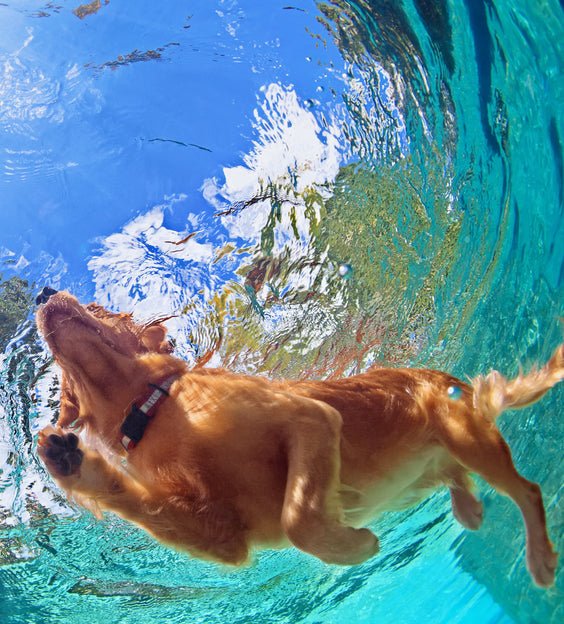Swimming, swimming, all summer long….. Who doesn’t love swimming? When introduced to water without worry, dogs are usually quick to embrace the fun of it.
It can be a hard intro for some dogs, and approaching it the right way will set the tone. Here are some things to consider when you set out to help your pup LOVE swimming and water fun!
Water Temps
Your pup’s introduction to water must be comfortable. While the air might feel warm, the water may be too cool for a youngster to enjoy. To help your pup learn that water is fun and pleasant, be sure the water is warm enough not to give them a chill and, consequently, a negative association.
Even if they are a sporting breed, built for cold water, use caution if it’s early or late in the season. Each of my Tollers has been willing to break through ice to swim as adult dogs. They have thick double coats purposely built for colder water adventures. However, while they are still pups, I’m cautious that water is a comfortable temperature as I develop positive associations with swimming.
The BEST start allows the pup or dog to confidently enjoy the water!
Debris
Their first intro to water should be in a relatively clean place. Beaver ponds or heavily cluttered shorelines might worry some pups initially. While you may be training a hunting companion whom you’ll eventually WANT to be able to navigate floating logs and other debris, introducing those things after your pup has learned to confidently navigate cleaner water will help them get there much faster!
Entry & Exit
I always teach the exit first! I find it helps the pup recognize that they have control over the situation if they know they can return to land anytime they feel the need. More importantly, it allows them to understand HOW to return to land if they're unsure. This will help them avoid feelings of panic entirely.
In the early days of swimming, I will find a place with a gradual entry that's calm. I will first play in the shallow water with the pup, allowing them to feel and enjoy the water. We might splash around, play little retrieve games along the shallow shore, run and chase a bit, and then, without making a big deal out of it, I'll move further into the water. Most times, the pup will follow happily.
As they get used to feeling more water on their bellies and sides, they might even follow me to the point where they lose touch with the bottom. Some pups take to water like they were born to be in it (as many were!)
If they aren't quite brave enough to leave the area they can touch on their own, but they're having FUN and aren't showing any signs of fear, I will gently lift them to the place they can barely touch, orient them towards the shore, place them in the water and let go. They might need to swim 1 or 2 strokes before feeling the solid bottom again. I will continue to play around and repeat the little swim from slightly further out each time until the pup figures out how to move in and out of the deeper water without worry.
Life Jackets
These can be helpful for pups who lack confidence when you are introducing them to the water, but more often, they will actually cause confusion. I avoid their use unless I have a pup who is struggling to make progress, but I DO use them if I take the pup in any vessel in case they tumble out of the boat. Accidents happen and I don’t want to risk my pup (or myself) panicking!
The life jacket will allow you to rescue your pup in a quick but calm fashion. Be sure to get one with a handle that will allow you to easily hoist your pup back into the boat. You can then be your pup's HERO!
Water is not without Danger
Water Toxicity
This can occur with humans as well as dogs. Water is excellent, but too much can be deadly. Some dogs drink copious amounts of water as they swim. Whether chasing bubbles or just lapping at the water, if yours is one of those dogs, use caution - especially when swimming in salt water. Sometimes, giving the dog a toy to carry will solve this problem for you. Other times, it will be essential to force breaks frequently.
Exhaustion
We all know the saying, “work like a dog,” because some dogs will work or play until they collapse. It's essential to know your dog and know what their regular activity cycle is like. If they aren't used to heavy amounts of exercise, keep swimming sessions in line with that.
Overstimulation
One tip I often give my students is to make sure they create more associations than just one… Often, we go to the water, and our dogs swim and play like mad, then we leave. This becomes a cycle, show up, party, and then it's done. Of course, the dog learns to get PUMPED at the sight of water, and it can be hard to bring them back down again.
Right from the start, find a balance! Spend time around water working with your pup on focus and even practicing calming exercises in addition to playing. This will pay off nicely for your pup as they grow and learn to listen, even when the water looks inviting. It will also allow you to force breaks when necessary without struggle.
The right introduction will ensure your pup is confident around water. Once they are, joy is just around the corner!
Until next time,
Happy Swimming!
Interested in swimming with your dog? Check out our Dock Diving Training

